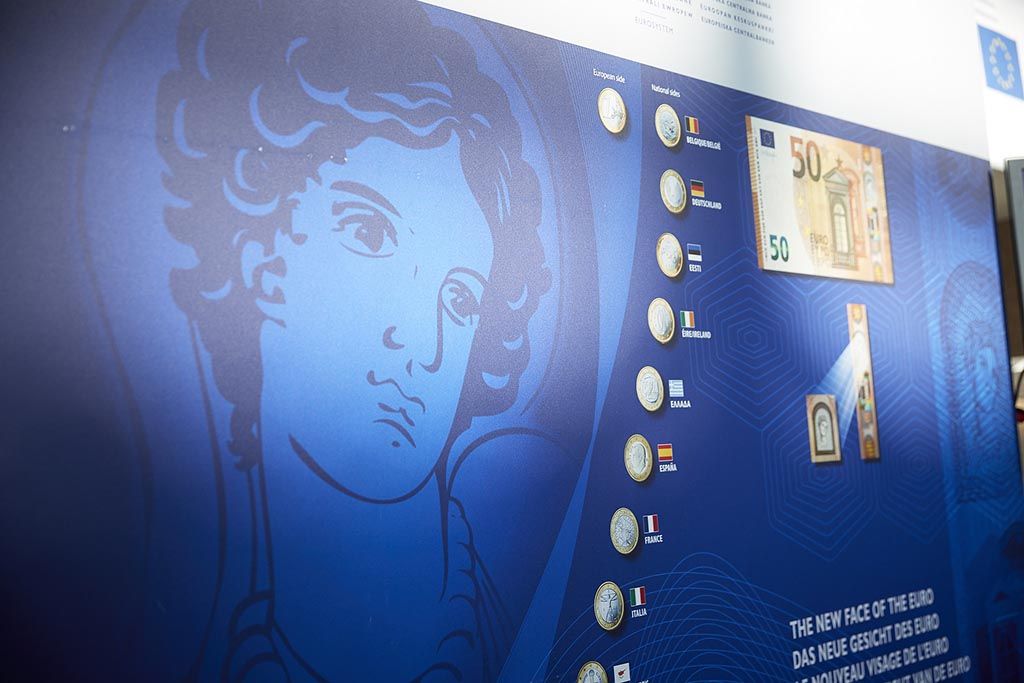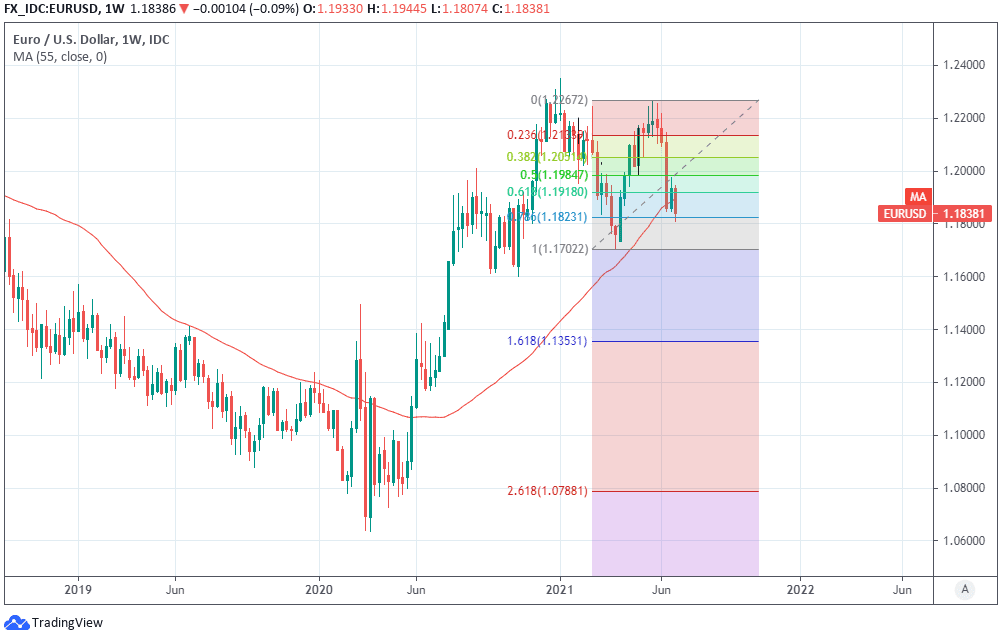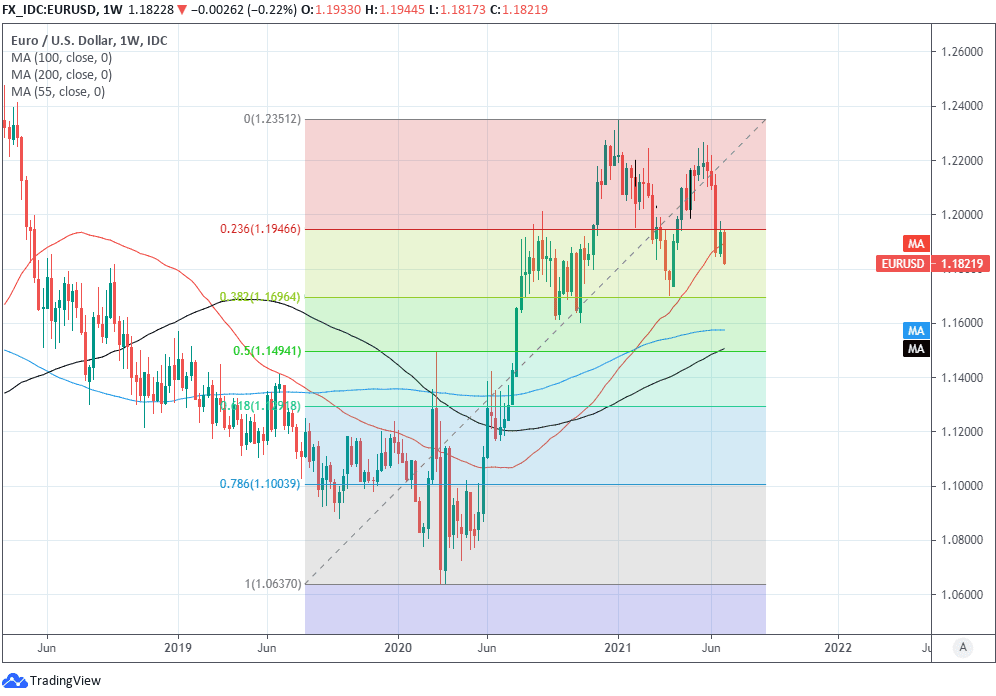Euro-Dollar Wrestles Key Chart Levels but Downside is Limited, Commerzbank Says
- Written by: James Skinner
- EUR/USD on course to cede 55-week average in early July
- Testing key Fib level near 1.1824 and risking further losses
- Further, more formidable support limits losses around 1.17

Image © European Central Bank
- EUR/USD reference rates at publication:
- Spot: 1.1838
- Bank transfers (indicative guide): 1.1420-1.1507
- Money transfer specialist rates (indicative): 1.1730-1.1755
- More information on securing specialist rates, here
- Set up an exchange rate alert, here
The Euro-to-Dollar exchange rate was near three-month lows ahead of the weekend and on course to give up its 55-week moving-average, which would warn of further potential losses to come, although commentary and forecasts from a range of analysts suggests that any additional downside may be somewhat limited.
Europe’s single currency had fallen to three-month lows against the greenback before better-than-expected American non-farm payrolls figures for the month of June were followed by widespread losses for Dollar exchange rates that had been strengthening for days ahead of the release.
While the Euro bounced alongside other currencies late in the final session of the week it remained below its 55-week moving-average against the Dollar, which is located around 1.1896, and would face an incremental headwind on the charts if the Euro-to-Dollar enters the weekend beneath that level given the discouraging effect it could have on would-be buyers of Europe’s single currency.
Friday’s post-payrolls rebound lifted the Euro off of the 78.6% Fibonacci retracement of its recovery rally from early April lows, which is another important chart level that has been providing support to EUR/USD around 1.1824, but with the single currency remaining below its 55-week average ahead of the weekend it may be just a matter of time before that support is tested again if-not overcome.
“EUR/USD has sold off to the 9th March low and the 78.6% Fibonacci retracement at 1.1836/24. This has held the initial test and we would allow for a near term bounce,” says Karen Jones, head of technical analysis for currencies, commodities and bonds at Commerzbank in a Friday morning note.
Above: Euro-to-Dollar rate shown at weekly intervals with 55-week average and Fibonacci retracements of April recovery rally.
Secure a retail exchange rate that is between 3-5% stronger than offered by leading banks, learn more.
“It stays negative while it remains below the 200 day moving average at 1.2001. Further down the April 5 low sits at 1.1738 and the March low can be spotted at 1.1704,” says Jones.
Commerzbank’s Jones has been a seller of the Euro since early in the week when it was trading around 1.1913 but took profits on the trade in a partial exit from it around 1.1845 ahead of the weekend.
She and the technical analysis team at Commerzbank have warned there’s a risk that the Euro-Dollar rate falls as far as 1.1602 over the next one-to-three weeks but have also flagged 1.1704 as an area in which the single currency could find support on the way down, if not stabilise around.
That intervening 1.1704 threshold may provide further support to the Euro and potentially of a more formidable kind given that just beneath it there is the 38.2% Fibonacci retracement of EUR/USD’s earlier double-digit percentage recovery from last year’s coronavirus-inspired lows near 1.06, which has already been tried and tested.
{wbamp-hide start}
{wbamp-hide end}{wbamp-show start}{wbamp-show end}
“Medium-term uncertainty remains high as to the level at which inflation and employment will level out once all covid-related special effects have been eliminated from the statistics. As a result, we would view further USD appreciation critically,” writes Esther Reichelt, another analyst at Commerzbank, in a Friday research note.
Other Commerzbank colleagues of Jones, who’re concerned less with price charts and more about economic fundamentals, reiterated Friday that “levels significantly below 1.18 in EUR-USD are not justified in our view,” citing a cloudy outlook for Federal Reserve (Fed) monetary policy that stems from lingering uncertainties about how soon the U.S. job market will recover from last year’s collapse and what the level of inflation will this time next year.
Above: Euro-to-Dollar rate shown at weekly intervals with 55, 100 and 200-week averages and Fibonacci retracements of 2020 recovery.
Much of the Euro’s recent decline has played out alongside a widespread strengthening of the U.S. Dollar and so may have little to do with events on the ground in the Eurozone where coronavirus vaccinations are accelerating and economies are advancing through the various stages of reopening, while aided by a supportive European Central Bank (ECB) monetary policy.
“We must not lose sight of the fact that the Fed keeps repeating that more data is required. Atlanta Fed President Raphael Bostic assumes that it will only become clearer from September onwards what exactly the recovery on the labour market will be like,” Reichelt says.







